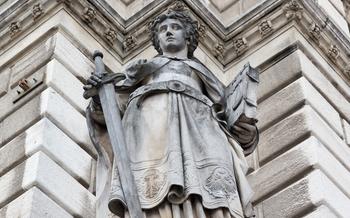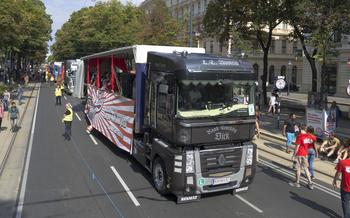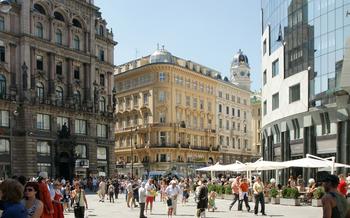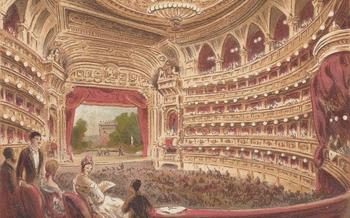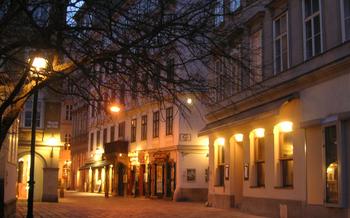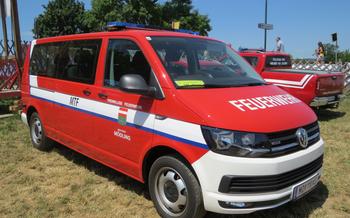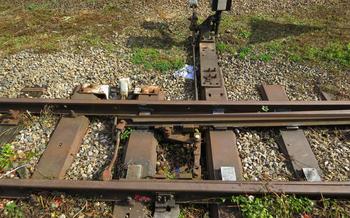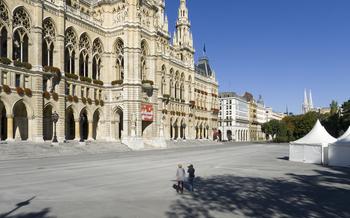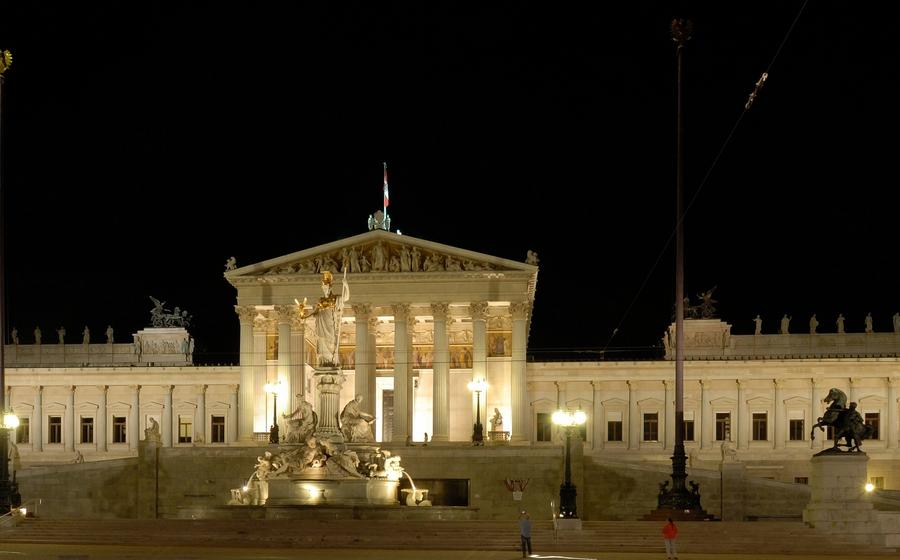
Austrian Parliament Building
- Orientation and Background
- What to See and Experience
- Exterior Highlights
- Interior Views
- The Great Hall
- Democracy in Action
- Events and Exhibitions
- Architektur and Design
- Symbolism and Allegory
- Historical Context
- Visiting Tips and Etiquette
- Best Time to Visit
- Accessibility and Facilities
- Nearby Attractions and Activities
- Local Cuisine and Dining Options
- Accommodation and Local Neighborhood
- Insider Tip: Rooftop Views
Orientation and Background
In the heart of Vienna, Austria, stands the majestic Austrian Parliament Building, a symbol of democracy and architectural grandeur. Completed in 1883, this neoclassical masterpiece was designed by Theophil Hansen, a renowned Danish architect. Its construction marked a significant chapter in Austrian history, as it replaced the temporary Reichsrat building, reflecting the growing need for a permanent seat of parliament.
The Parliament Building is situated on the Ringstrasse, a grand boulevard lined with impressive historical structures. Its location is easily accessible by public transportation, with several tram and subway lines connecting visitors to this iconic landmark. Guided tours are available, offering a deeper insight into the building's history, architecture, and its role in Austrian democracy.
What to See and Experience
Exterior Highlights
The Parliament Building's façade is adorned with an array of sculptures and architectural features that symbolize Austria's history and culture. The central pediment features a sculpture of Pallas Athena, the Greek goddess of wisdom and war, representing the importance of knowledge and justice in democracy. Above the main entrance, a frieze depicts scenes from Austrian history, including the signing of the constitution and the Battle of Vienna in 168
The building's exterior is also adorned with statues of famous Austrian figures, such as Emperor Franz Joseph I, Empress Maria Theresa, and composer Wolfgang Amadeus Mozart. These statues pay tribute to individuals who have made significant contributions to Austria's history and culture.
Interior Views
The interior of the Parliament Building is just as impressive as its exterior. The grand entrance hall features a marble staircase leading to the upper floors. The walls are lined with portraits of former Austrian chancellors and presidents, as well as paintings depicting historical events.
The most impressive room in the Parliament Building is the National Council Chamber, where the Austrian Parliament meets. The chamber is decorated with ornate chandeliers, tapestries, and paintings. The ceiling is adorned with a mural depicting scenes from Austrian history, including the signing of the constitution and the Battle of Vienna in 168
The Great Hall
The Great Hall is a magnificent room used for special events and ceremonies. It is decorated with a series of murals depicting scenes from Austrian history, such as the Battle of Vienna and the signing of the Treaty of Schönbrunn. The ceiling of the hall is adorned with a large chandelier made of crystal and bronze.
The Great Hall is also used for concerts and other cultural events. It is a popular venue for performances by the Vienna Philharmonic Orchestra and the Vienna Boys' Choir.
Democracy in Action
The Austrian Parliament is not merely a stunning architectural marvel but also the heart of Austrian democracy, where the country's laws are debated and shaped. The Parliament convenes regularly, typically on Tuesdays and Wednesdays, and visitors are welcome to observe these sessions from the public gallery. These sessions offer a fascinating glimpse into the workings of Austrian democracy, as elected representatives engage in lively debates, present arguments, and cast their votes on important issues affecting the nation.
The Austrian Parliament is home to several political parties, each representing a diverse range of ideologies and perspectives. These parties work together to form a coalition government, which is responsible for governing the country. Visitors to the Parliament Building can learn about the different political parties, their platforms, and how they contribute to the dynamic political landscape of Austria.
The Parliament also plays a crucial role in the lawmaking process. Visitors can gain insights into how laws are created, amended, and passed in Austria. They can witness firsthand the deliberations, negotiations, and compromises that take place before a bill becomes law. The Parliament's role in shaping the nation's laws and policies highlights its importance as a cornerstone of Austrian democracy.
Events and Exhibitions
The Austrian Parliament Building is a vibrant venue for various events and exhibitions showcasing Austrian art, history, and culture. Special exhibitions are held periodically, highlighting diverse themes related to Austria's rich heritage. These exhibitions often feature valuable artworks, historical artifacts, and interactive displays that offer visitors a deeper understanding of the country's past and present.
The Parliament Building also hosts notable concerts, recitals, and performances by renowned artists from Austria and around the world. The grand halls and chambers provide an elegant and acoustically superb setting for these events, creating a memorable experience for attendees. From classical music concerts to contemporary performances, there is a diverse range of events to cater to different tastes and preferences.
Additionally, the building serves as a magnificent backdrop for state ceremonies, official receptions, and other significant events. Presidential inaugurations, diplomatic gatherings, and commemorative ceremonies are often held within its walls, adding to its historical significance and grandeur. These events offer visitors a glimpse into the formal proceedings and traditions of Austrian democracy.
Architektur and Design
The Austrian Parliament Building is a masterpiece of Neoclassical architecture, inspired by the architectural forms of ancient Greece and Rome. Theophil Hansen, a renowned Danish architect, was commissioned to design the building in the latter half of the 19th century. Hansen's vision for the Parliament Building was to create a structure that would embody the democratic ideals and national identity of Austria.
The building's exterior is characterized by its grand façade, adorned with intricate carvings, sculptures, and monumental columns. The iconic pediment above the main entrance features a sculptural group depicting the enthronement of Austria as a constitutional monarchy. The interior of the Parliament Building is equally impressive, showcasing opulent halls, chambers, and public spaces. The National Council Chamber, where the Austrian Parliament convenes, is a particularly noteworthy feature. This grand hall is decorated with marble, gold leaf, and intricate carvings, reflecting the significance of the legislative body it houses.
Hansen's attention to detail is evident throughout the building, from the grand staircases to the ornate chandeliers. The use of marble, granite, and other fine materials adds to the building's grandeur and reinforces its status as a symbol of Austrian democracy. The Parliament Building stands as a testament to Hansen's architectural prowess and his significant contributions to the architectural landscape of Vienna.
Symbolism and Allegory
The Austrian Parliament Building is adorned with a wealth of statues, sculptures, ceiling murals, and insignia that hold profound symbolic and allegorical meanings. These artistic elements serve to elevate the building beyond its functional purpose, transforming it into a repository of Austrian history, culture, and national identity.
Statues and Sculptures
The statues and sculptures adorning the Parliament Building's façade and interior spaces represent historical figures, mythological deities, and allegorical themes. These works of art contribute to the building's grandeur and provide visual narratives that evoke Austria's rich past and cultural heritage.
Ceiling Murals
The grand chambers and halls of the Parliament Building are adorned with magnificent ceiling murals depicting historical events and allegorical representations. These murals serve as visual testaments to Austria's journey as a nation, from its imperial past to its present-day status as a democratic republic.
Coat of Arms and Insignia
The Austrian coat of arms, prominently displayed throughout the building, features a double-headed eagle, a symbol of imperial power and authority. Other insignia, such as the flags of Austria's nine federal states, further reinforce the building's significance as a symbol of national unity and identity.
Historical Context
The Austrian Parliament Building stands as a testament to Austria's rich history and political evolution. During the Habsburg Empire, it served as the seat of the Imperial Council, the legislative body of the vast multi-ethnic empire. The building witnessed the rise and fall of the Habsburg dynasty, which ruled Austria for over six centuries.
With the collapse of the empire after World War I, Austria transitioned to a republic, and the Parliament Building became the home of the newly established Austrian Parliament. The building has played a crucial role in shaping Austria's modern democracy, hosting debates, passing laws, and serving as a symbol of national unity.
During World War II, the Parliament Building miraculously survived Allied bombings, despite being located near several targets. Its resilience became a symbol of Austrian determination and the enduring spirit of democracy. After the war, the building underwent extensive renovations to restore it to its former glory, a testament to the nation's commitment to rebuilding and moving forward.
Visiting Tips and Etiquette
When visiting the Austrian Parliament Building, adhering to certain protocols and guidelines enhances the overall experience. Visitors should dress appropriately, considering the formal setting. Conservative attire, such as business casual or smart casual, is recommended to show respect for the institution.
Security checks are in place to ensure the safety of all visitors. Be prepared to undergo security screenings, including passing through metal detectors and having bags inspected. Cooperation with security personnel is essential for a smooth and efficient entry process.
Photography and videography are generally permitted within the Parliament Building, but certain restrictions may apply. Visitors should be mindful of signs indicating areas where photography or filming is prohibited. Using flash photography or tripods may also be restricted to preserve the integrity of the building and its exhibits.
Best Time to Visit
The best time to visit the Austrian Parliament Building depends on your preferences and the specific experiences you seek. Here are some factors to consider:
-
Seasonal Factors: Vienna experiences a continental climate with warm summers and cold winters. Visiting during the summer months (June to August) offers pleasant weather for outdoor exploration and allows you to enjoy the lively atmosphere of the city. However, keep in mind that this is also the peak tourist season, so expect larger crowds and higher prices.
-
Special Events: Throughout the year, the Parliament Building hosts various special events and festivals that can enhance your visit. For example, the "Lange Nacht der Museen" (Long Night of Museums) in October offers extended hours and special programs at museums across Vienna, including the Parliament Building. The "Wiener Festwochen" (Vienna Festival Weeks) in May and June showcase a diverse range of performing arts, often including events at the Parliament Building.
-
Guided Tour Availability: Guided tours of the Parliament Building are available throughout the year, but the frequency and availability may vary depending on the season and demand. It's advisable to book your tour in advance, especially during peak tourist season, to secure your spot.
Accessibility and Facilities
The Austrian Parliament Building is committed to providing a welcoming and accessible environment for all visitors, regardless of their abilities. Accessibility features include wheelchair ramps and elevators, ensuring that all areas of the building are accessible to visitors with disabilities. Visitors with visual or hearing impairments can request assistive listening devices or sign language interpreters upon advance notice. The building also offers amenities such as restrooms, cafes, and a gift shop for visitors' convenience.
For families with young children, the Parliament Building provides several child-friendly activities and programs. Guided tours are available specifically designed for children, with interactive elements and storytelling to engage young learners. The building also offers a play area for children, where they can enjoy supervised playtime while their parents explore the building.
Nearby Attractions and Activities
In the vicinity of the Parliament Building, a world of history, art, and culture awaits. Take a leisurely stroll to the magnificent Hofburg Palace, the former imperial residence of the illustrious Habsburg dynasty. Explore its opulent state rooms, museums, and gardens, gaining insights into the grandeur and opulence of Austria's royal past.
A short walk from the Parliament Building, discover the Museumsquartier, a vibrant cultural district teeming with artistic treasures. Immerse yourself in the world of modern art at the MUMOK, explore the history of photography at the WestLicht Museum, or delve into the history of natural history at the Naturhistorisches Museum.
For a delightful evening of opera or ballet, the Vienna State Opera, just a stone's throw from the Parliament Building, beckons with its world-renowned performances. Marvel at the architectural grandeur of this iconic opera house and experience the magic of a live performance in one of the world's most prestigious venues.
Local Cuisine and Dining Options
When in Vienna, immersing yourself in the local culinary delights is a must. The city is renowned for its traditional Viennese cuisine, a blend of Austrian and Central European influences. While visiting the Parliament Building, take the opportunity to explore the nearby dining options and savor some authentic Austrian dishes.
Indulge in the iconic Wiener Schnitzel, a breaded and fried cutlet made from veal, served with potato salad and lingonberry jam. Another classic dish is Tafelspitz, boiled beef served with horseradish sauce, chives, and roasted potatoes. For a lighter option, try Kaiserschmarrn, a shredded pancake served with powdered sugar and plum compote.
For a sweet treat, Vienna is famous for its Sacher Torte, a rich chocolate cake with a layer of apricot jam, covered in dark chocolate ganache. Don't miss the Apfelstrudel, a flaky pastry filled with apples, raisins, cinnamon, and sugar.
To fully embrace the Viennese coffee culture, visit one of the many traditional cafes in the vicinity of the Parliament Building. Order a Melange, a Viennese variation of the cappuccino, or a Kaffee und Kuchen, a coffee accompanied by a slice of cake.
Vienna's culinary scene is diverse and offers something for every palate. Whether you prefer traditional Austrian dishes or international cuisine, you'll find plenty of options to satisfy your cravings while exploring the city's landmarks, including the magnificent Parliament Building.
Accommodation and Local Neighborhood
When planning your stay in Vienna, consider lodging options near the Parliament Building to make the most of your visit. Numerous reputable hotels, guesthouses, and vacation rentals are within walking distance, offering a range of choices to suit various budgets and preferences.
Explore the surrounding neighborhood, steeped in history and lined with elegant buildings. Take a leisurely stroll along the Ringstrasse, the grand boulevard that circles the city center, and admire the impressive architecture, including the Burgtheater, the University of Vienna, and the Kunsthistorisches Museum.
Vienna's efficient public transportation system makes it easy to explore the city from the Parliament Building. Hop on the U-Bahn (metro) or tram to reach other attractions, such as Schönbrunn Palace, the Belvedere Museum, or the Prater amusement park. Immerse yourself in Viennese culture and enjoy the city's vibrant atmosphere.
Insider Tip: Rooftop Views
For a breathtaking perspective of Vienna, venture to the rooftop terrace of the Parliament Building. While not always accessible to the public, on certain occasions, guided tours may offer the opportunity to ascend to this hidden gem. From this vantage point, you'll be rewarded with panoramic vistas of the city's architectural marvels, including the spires of St. Stephen's Cathedral, the Hofburg Palace, and the surrounding cityscape. It's a unique chance to capture the essence of Vienna's grandeur and immerse yourself in its rich history.
